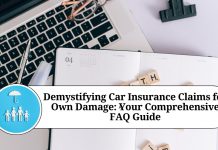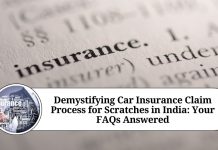Introduction
Car insurance provides crucial financial protection in case of accidents or damage to your vehicle. Accidents can happen to anyone, regardless of how careful a driver you are. When your car sustains damage due to unforeseen circumstances, filing a claim with your insurance company becomes essential. In this blog post, we will guide you through the process of claiming car insurance for own damage, empowering you to handle the situation efficiently and effectively.
- Document the Incident: The first step after your car sustains damage is to document the incident thoroughly. This includes taking photographs of the damage from different angles, capturing the surrounding scene, and noting down relevant details like the time, date, and location of the incident. This documentation will serve as essential evidence when you file your insurance claim.
- Assess the Damage: Before contacting your insurance company, assess the extent of the damage to your vehicle. If it is a minor repair, you might consider paying for it out of pocket to avoid potential premium increases. However, for significant damage or repairs that exceed your budget, filing a claim is the best course of action.
- Review Your Insurance Policy: Carefully review your car insurance policy to understand the coverage and exclusions related to own damage. Familiarize yourself with the terms and conditions, deductible amounts, and any specific procedures outlined by your insurance provider. This knowledge will help you navigate the claims process smoothly.
- Notify Your Insurance Company: Contact your insurance company as soon as possible to inform them about the incident. Provide them with all the necessary details and documentation you gathered during the initial steps. Be prepared to answer any questions they may have, as this will aid in expediting your claim.
- File a Formal Claim: Your insurance company will guide you through the process of filing a formal claim. They will provide you with the required claim form or direct you to an online portal where you can submit the necessary information. Fill out the form accurately, providing all the relevant details about the incident, the damage sustained, and any injuries involved.
- Arrange for Vehicle Inspection: In most cases, the insurance company will require an inspection of your vehicle to assess the damage and determine the cost of repairs. Arrange a convenient time and location with the insurance company or their authorized representative for this inspection. Ensure that the damaged vehicle is easily accessible for inspection purposes.
- Obtain Repair Estimates: After the inspection, your insurance company may ask you to obtain repair estimates from authorized garages or workshops. Contact these establishments and provide them with the necessary information to receive accurate estimates for the repairs. Submit these estimates to your insurance company for review and approval.
- Follow Claims Process: Once your claim is approved, the insurance company will guide you through the remaining steps of the claims process. They may choose to settle the claim by directly paying the repair shop, reimbursing you after you pay for the repairs, or providing you with a cash settlement based on the assessed value of your vehicle.
- Keep Track of Communications: Throughout the entire claims process, maintain a record of all communications, including emails, phone calls, and any documentation exchanged between you and the insurance company. This documentation will serve as a reference in case of any disputes or discrepancies that may arise.
- Stay Patient and Persistent: Sometimes the claims process can take time, so it’s important to remain patient. Be persistent in following up with your insurance company, politely seeking updates on the progress of your claim. Clear communication and professionalism will help facilitate a smoother process.
Conclusion
Claiming car insurance for own damage can be a complex process, but with the right knowledge and preparedness, you can navigate it successfully. Remember to document the incident, assess the damage, review your insurance policy.
Other Related Blogs: Section 144B Income Tax Act
Frequently Asked Questions (FAQs)
Q1: What is own damage car insurance?
A1: Own damage car insurance, also known as comprehensive car insurance, provides coverage for damages to your own vehicle resulting from accidents, theft, vandalism, natural disasters, or other specified events. It is different from third-party liability insurance, which covers damages to other vehicles or property caused by your vehicle.
Q2: What should I do immediately after my car sustains own damage?
A2: After your car sustains own damage, it’s crucial to document the incident by taking photographs of the damage, noting down the time, date, and location, and gathering any relevant information. This documentation will be helpful when filing an insurance claim.
Q3: How do I file a claim for own damage car insurance?
A3: To file a claim for own damage car insurance, you should notify your insurance company about the incident as soon as possible. Provide them with all the necessary details and documentation, and follow their instructions for filing a formal claim, which may involve filling out a claim form or using an online portal.
Q4: What information do I need to provide when filing a claim for own damage car insurance?
A4: When filing a claim, you will typically need to provide details such as the date, time, and location of the incident, a description of what happened, photographs of the damage, and any supporting documents or police reports, if applicable.
Q5: Will filing a claim for own damage car insurance affect my premium?
A5: Filing a claim for own damage car insurance may impact your premium. Your insurance provider may increase your premium upon renewal, especially if you have made multiple claims or if the damage is significant. However, the exact impact on your premium will depend on various factors, including your insurance policy and claims history.
Q6: How does the claims process work for own damage car insurance?
A6: The claims process for own damage car insurance typically involves notifying your insurance company, filing a formal claim, arranging for a vehicle inspection, obtaining repair estimates, and following the guidance provided by your insurance company. The process may vary slightly depending on your insurance provider.
Q7: How long does it take to settle an own damage car insurance claim?
A7: The time taken to settle an own damage car insurance claim can vary depending on the complexity of the case, the extent of the damage, and the responsiveness of all parties involved. Some claims can be settled within a few weeks, while others may take longer. Regularly communicate with your insurance company for updates on the progress of your claim.
Q8: Can I choose my own repair shop for the repairs?
A8: Some insurance policies allow you to choose your own repair shop, while others may have a list of authorized garages or workshops from which you must obtain repair estimates. Review your insurance policy or check with your insurance company to determine the guidelines for repair shop selection.
Q9: What if the repair costs exceed the assessed value of my vehicle?
A9: If the repair costs exceed the assessed value of your vehicle, it may be considered a total loss. In such cases, your insurance company may offer a cash settlement based on the assessed value of the vehicle rather than covering the repair costs. Consult with your insurance provider to understand their specific procedures and policies for total loss situations.
Q10: What should I do if I disagree with the insurance company’s claim settlement offer?
A10: If you disagree with the claim settlement offer from your insurance company, you should review your policy and gather any additional evidence or documentation that supports your position. Communicate your concerns and present your case to the insurance company, requesting a reconsideration of the settlement. If necessary, you can seek legal advice or contact an ombudsman or regulatory body for assistance.




















